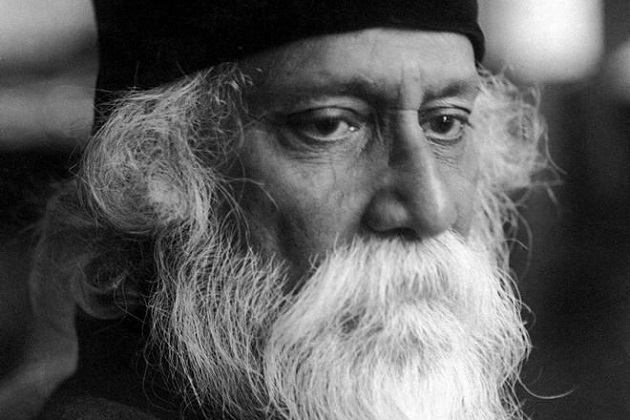Rabindranath Tagore 157th birth anniversary 5 lesser known facts about India s first Nobel laureate
Nation remembers Rabindranath Tagore, a revered poet, mercurial writer, calming musician and a cursive painter to commemorate his 157th birth anniversary on Monday, May 7, 2018.
Tagore, the first Nobel laureate of India was a born poet and started writing poetry when he was merely eight years old.
The 'Kavi Guru' was only 16 when he released his first collection of poems under the pseudonym 'Bhanusimha'.
Tagore, who began painting much later in his life, had made more than 3,000 paintings and drawings in the last 17 years of his life.
He did not have a formal training in art but created a variety of images. He started to paint as painting is a universal language and can reach everyone without the need to be translated.
After he developed his love for painting, Tagore described the visible world around him as a vast procession of forms. Most of the landscapes he painted showed nature bathed in the evening light, skies and forms coagulating into ominous silhouettes. His landscapes invoke mystery and a sense of disquiet and silence.
Be it his style of writing or describing the world through his 'out of the ordinary' canvas, Tagore's works always showcased his love for humanity.
As the nation celebrates Gurudev's birthday on May 7, here are some lesser known facts about the gem.
News Nation Bureau | Updated : 07 May 2018, 02:22:37 PM

Rabindranath Tagore 157th birth anniversary: 5 lesser known facts about India's first Nobel laureate
Nation remembers Rabindranath Tagore, a revered poet, mercurial writer, calming musician and a cursive painter to commemorate his 157th birth anniversary on Monday, May 7, 2018.
Tagore, the first Nobel laureate of India was a born poet and started writing poetry when he was merely eight years old.
The 'Kavi Guru' was only 16 when he released his first collection of poems under the pseudonym 'Bhanusimha'.
Tagore, who began painting much later in his life, had made more than 3,000 paintings and drawings in the last 17 years of his life.
He did not have a formal training in art but created a variety of images. He started to paint as painting is a universal language and can reach everyone without the need to be translated.
After he developed his love for painting, Tagore described the visible world around him as a vast procession of forms. Most of the landscapes he painted showed nature bathed in the evening light, skies and forms coagulating into ominous silhouettes. His landscapes invoke mystery and a sense of disquiet and silence.
Be it his style of writing or describing the world through his 'out of the ordinary' canvas, Tagore's works always showcased his love for humanity.
As the nation celebrates Gurudev's birthday on May 7, here are some lesser known facts about the gem.

Rabindranath Tagore 157th birth anniversary: 5 lesser known facts about India's first Nobel laureate
1. Composed National Anthems for three nations:
Tagore is the only known person, who composed the national anthems for three different countries. He wrote 'Jana Gana Mana' for India 'Amar Sonar Bangla' for Bangladesh and 'Nama Nama Sri Lanka Mata' in Bengali for Sri Lanka.

Rabindranath Tagore 157th birth anniversary: 5 lesser known facts about India's first Nobel laureate
2. Lack of family concern:
Tagore was raised mostly by servants since his mother Sarada Devi died in his early childhood and his father Debendranath Tagore travelled widely across the world. The Tagore family was at the forefront of the Bengal renaissance.

Rabindranath Tagore 157th birth anniversary: 5 lesser known facts about India's first Nobel laureate
3. Had no academic qualification:
Tagore skipped the conventional classroom schooling and preferred to roam the manor or nearby Bolpur and Panihati, which the family visited. His brother Hemendranath tutored and physically conditioned him by having him swim the Ganges or trek through hills, by gymnastics, and by practicing judo and wrestling. Moreover, Tagore's father invited several professional teachers, musicians and painters to stay in the house and teach his children.

Rabindranath Tagore 157th birth anniversary: 5 lesser known facts about India's first Nobel laureate
4. Beautiful friendship with Albert Einstein:
It was on the edge of Berlin on July 14, 1930 that Science and Spirituality came together. Einstein welcomed the Indian philosopher in his house and later met him several times in 1931. They also shared a few common interests both in Music and general awareness. Talking about Einstein, Tagore wrote, "There was nothing stiff about him - there was no intellectual aloofness. He seemed to me a man who valued human relationship and he showed toward me a real interest and understanding."

Rabindranath Tagore 157th birth anniversary: 5 lesser known facts about India's first Nobel laureate
5. Returning 'Knighthood' title in protest against Jallianwala Bagh massacre:
Rabindranath Tagore, who is also known as the 'Bard of Bengal', returned his 'Knighthood' title given by the then British rulers in India. The decision was taken in protest of Jallianwala Bagh massacre, which took place in 13 April, 1919. In the horrific incident, the troops of the British Indian Army under the command of Colonel Reginald Dyer fired rifles into a crowd of Baishakhi pilgrims, who gathered in Jallianwala Bagh, Amritsar, Punjab. "The time has come when the badge of honour makes our shame glaring in their incongruous text of humiliation, and I, for my part, wish to stand shorn of all special distinctions, by the side of those of my countrymen who, for their so-called insignificance are liable to suffer degradation not fit for human beings," Tagore wrote in his letter to the viceroy.










